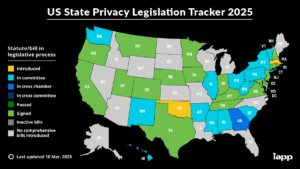Navigating TV Attribution:
How Machine Learning Helps Avoid
the Pitfalls of IP Addresses
The television attribution landscape is undergoing rapid transformation, presenting stakeholders with a pivotal decision:
Continue relying on traditional methods such as IP addresses and device IDs, or pivot toward the adoption of machine learning (ML). This choice holds substantial implications, particularly considering stringent privacy regulations entering into force.

There are two primary hurdles associated with utilizing IP addresses for TV attribution.
First, using IP addresses as identifiers raises privacy concerns and potential legal
consequences since they can easily be linked to personally identifiable information (PII).
Regulations, like the California Consumer Privacy Act (CCPA) and the General Data
Protection Regulation (GDPR), set strict guidelines for handling personal data — thus,
relying on IP addresses might risk violating these regulations.
Second, IPs and device IDs used in attribution are increasingly causing inaccuracies in measurement. Here are the top three reasons why:
- Dynamic IP Assignments
The increasing use of dynamic IP assignments by
internet service providers (ISPs) complicates linking a specific IP address to a
unique user. Dynamic assignments introduce variability, making it difficult to
maintain accuracy in TV attribution. Advertisers relying on static IP-based
models may encounter inaccuracies that compromise the reliability of their
attribution data.
- Challenge of VPN Usage
The widespread adoption of virtual private
networks (VPNs) further complicates IP address-based TV attribution. VPNs
mask users’ true IP addresses, making it challenging to accurately attribute
TV viewership to specific locations. As individuals turn to VPNs for enhanced
privacy and security, advertisers must grapple with the reality that relying
solely on IP addresses has become more and more unreliable, potentially
leading to misinterpretations of audience demographics. attribution data.
- Blind Spots
- Blind Spots
Another challenge arises with the utilization of IP addresses and
other device identifiers, as they cannot legally be employed to gauge the
impact of TV commercials on specific protected demographics. These
limitations result in a substantial gap in measurements.
It’s no surprise that major brands are witnessing a decline in trust for traditional identifiers. This shift has pushed them towards leveraging ML in TV attribution for strategic advantages.
Machine learning excels in analyzing anonymized and aggregated data, effectively addressing privacy concerns while extracting valuable insights. By focusing on patterns and trends rather than individual user data, advertisers can extract actionable
information without compromising user privacy. This approach not only adheres to
privacy regulations but also fosters a more ethical handling of customer information.
With the correct ML implementation, not only can high accuracy be achieved, but it can
also provide a comprehensive understanding of the customer journey.
Unlike simplistic IP-based attribution models, ML considers various factors and enables forecasting, resulting in a more accurate representation of how TV ads contribute to conversions, guiding advertisers toward more informed decision-making.
Transitioning from IP address-based TV attribution to ML allows brands and agencies to overcome the limitations associated with IP addresses, embracing a more sophisticated, privacy-conscious, and regulation-compliant approach.
This positions advertisers at the forefront of ethical and effective advertising practices, which is imperative for success in an evolving industry where the adoption of advanced technologies is crucial.
Ready to discover a safer, more accurate approach to TV Attribution? Visit RSLT TV to learn more.
The television attribution landscape is undergoing rapid transformation, presenting stakeholders with a pivotal decision:
Continue relying on traditional methods such as IP addresses and device IDs, or pivot toward the adoption of machine learning (ML). This choice holds substantial implications, particularly considering stringent privacy regulations entering into force.

There are two primary hurdles associated with utilizing IP addresses for TV attribution.
First, using IP addresses as identifiers raises privacy concerns and potential legal
consequences since they can easily be linked to personally identifiable information (PII).
Regulations, like the California Consumer Privacy Act (CCPA) and the General Data
Protection Regulation (GDPR), set strict guidelines for handling personal data — thus,
relying on IP addresses might risk violating these regulations.
Second, IPs and device IDs used in attribution are increasingly causing inaccuracies in measurement. Here are the top three reasons why:
- Dynamic IP Assignments
The increasing use of dynamic IP assignments by internet service providers (ISPs) complicates linking a specific IP address to a unique user. Dynamic assignments introduce variability, making it difficult to maintain accuracy in TV attribution. Advertisers relying on static IP-based
models may encounter inaccuracies that compromise the reliability of their attribution data.
- Challenge of VPN Usage
The widespread adoption of virtual private
networks (VPNs) further complicates IP address-based TV attribution. VPNs mask users’ true IP addresses, making it challenging to accurately attribute TV viewership to specific locations. As individuals turn to VPNs for enhanced privacy and security, advertisers must grapple with the reality that relying solely on IP addresses has become more and more unreliable, potentially leading to misinterpretations of audience demographics. attribution data.
- Blind Spots
Another challenge arises with the utilization of IP addresses and other device identifiers, as they cannot legally be employed to gauge the impact of TV commercials on specific protected demographics. These limitations result in a substantial gap in measurements.
It’s no surprise that major brands are witnessing a decline in trust for traditional identifiers. This shift has pushed them towards leveraging ML in TV attribution for strategic advantages.
Machine learning excels in analyzing anonymized and aggregated data, effectively addressing privacy concerns while extracting valuable insights. By focusing on patterns and trends rather than individual user data, advertisers can extract actionable
information without compromising user privacy. This approach not only adheres to privacy regulations but also fosters a more ethical handling of customer information.
With the correct ML implementation, not only can high accuracy be achieved, but it can
also provide a comprehensive understanding of the customer journey.
Unlike simplistic IP-based attribution models, ML considers various factors and enables forecasting, resulting in a more accurate representation of how TV ads contribute to conversions, guiding advertisers toward more informed decision-making.
Transitioning from IP address-based TV attribution to ML allows brands and agencies to overcome the limitations associated with IP addresses, embracing a more sophisticated, privacy-conscious, and regulation-compliant approach.
This positions advertisers at the forefront of ethical and effective advertising practices, which is imperative for success in an evolving industry where the adoption of advanced technologies is crucial.




